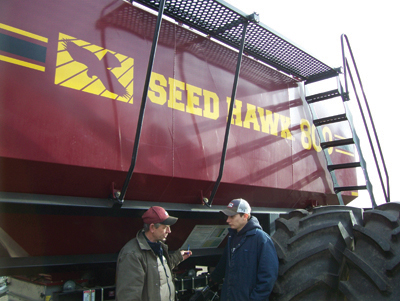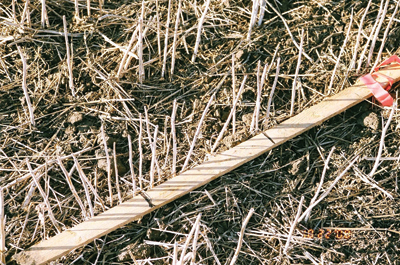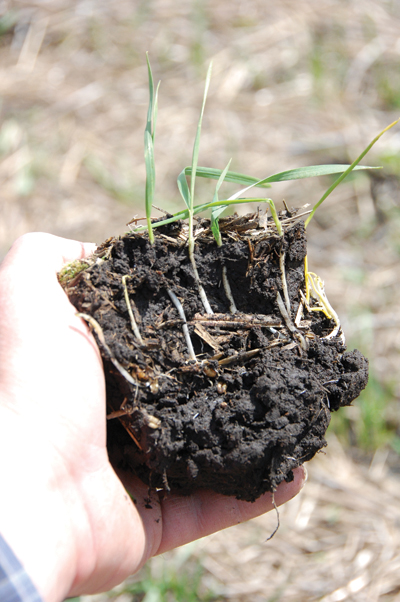
Features
Agronomy
Tillage
The importance of uniform crop establishment
Chris Thibarge has been involved in providing agronomic advice to growers in the southern Peace River region, 28 years as an employee of the Ag-industry and with 25 years of no-till experience.
March 2, 2009 By Top Crop Manager
Chris Thibarge has been involved in providing agronomic advice to growers in the southern Peace River region, 28 years as an employee of the Ag-industry and with 25 years of no-till experience. During that period of time, he developed many close relationships with the growers he came into contact with. It was becoming evident to him that due to the restructuring of the industry, it would be difficult to maintain the required close contact with growers and their fields. In 2004, based on grower encouragement, he decided to establish MACHELMI Ag Consulting as his own independent crop consulting business at Sexsmith, Alberta.
 |
|
| CCA Chris Thibarge (left) discusses impact of spring weather conditions on seeding rates and seeding depths with Devon Linden of Linden Farms. |
In speaking with Chris, it readily becomes apparent that crop establishment is one aspect of the cropping system that he is especially passionate about: doing everything possible to get the crop off to a rapid and uniform start. He emphasizes that, “To me, achieving a uniform stand is the most critical goal in the entire farming operation.” He goes on to point out that attaining this goal has a dramatic impact on the success of all subsequent cropping operations. He indicates that, “Achieving a uniform stand also leads to uniform spraying operations and uniform flowering.”
A uniform stand also leads to uniform crop maturity and uniform grades. Chris states, “Miss the first uniform and any chance of achieving the other uniforms is gone, along with a significant loss in crop production efficiency and profit.”
Favours sidebanding fertilizer
Chris also has very strong opinions about how a grower should go about attempting to achieve a uniform crop stand in direct or no-till seeding systems. Based on Agriculture Canada research that he has observed at Lacombe and the Peace River region, he favours a seeding system that sidebands the fertilizer at the time of seeding. He points out that as a university student, he learned that the most effective way to apply fertilizer would be to place it 1.5 to 2.0 inches to the side of the seedrow and an equal distance below the depth of seeding (although the seeding tools that would allow growers to achieve this type of fertilizer placement were not available at the time).
 |
|
| Post-harvest illustration of the excellent and very uniform stand emergence that was achieved with canola on Linden Farms in 2008, using a Seed Hawk air seeder travelling at 3.2 mph with a seeding rate of 4.5 lbs/ac. Based on the results achieved, Linden Farms is considering reducing its canola seeding rate by 10-15 percent. | |
 |
|
| In residue-covered, no-till fields, during a cold and wet spring, uniform and rapid crop emergence may be difficult to achieve using a disc opener. Note that residue has been hair-pinned directly into the seedrow, leaving seedlings vulnerable to higher levels of disease pressure. |
Chris points out that, based on the rooting habits of our crops, “Placing fertilizer in a sideband is the best way of ensuring that crop has early and uniform access to these nutrients.” With the recent introduction of several air seeders, sideband application of fertilizer in a direct seeding or no-till has become quite feasible. Thibarge feels that the best seeding system for achieving his fertilizer placement and seeding goals is the Conserva-Pak drill. Chris indicates that the Seed Hawk drill, which achieves a very similar geometry in seed and fertilizer placement, is equally effective. He also feels that both also do an excellent job of getting the seed effectively placed in the soil, thereby increasing the odds of achieving uniform crop establishment.
Thibarge admits he prefers seeding equipment that has the capability to sideband fertilizer at the time of seeding. However, he indicates that 50 percent of his growers use seeding equipment with mid-row band fertilizer placement, and that all of these growers are equally successful farm operators. For those using mid-row fertilizer banding, he emphasizes the importance of using starter fertilizer to ensure the crop gets off to a rapid start. For direct seeding, disc openers are not always effective in cold, clay-type soils in wet springs. Residue covered fields can be slow to warm and can be plagued with hair-pinning problems. However, Chris has observed that in fields coming out of grass seed production, disc openers can achieve excellent stands of RR canola, providing a proper herbicide burn-down is achieved.
Based on his some 40 years of intimate contact with growers and their fields, Chris points out that, “There are many different air seeding systems that have been successfully adopted by Peace Region growers. The key is to stay within the limitations of their seeding equipment. However, I believe that growers can negatively push their seeding equipment beyond its design limitations. For example, attempting to seed more acres per hour than the equipment is capable of effectively accomplishing, resulting in a less than desirable stand.”
Growers need to be observant
Thibarge places a high level of emphasis on monitoring seeding depth and seeding rates to achieve a target plant stand population. He works with his growers to use data on seed (1000 kernel) weight, percent germination, and vigour to establish a realistic seeding rate for achieving the grower’s target plant population. He recognizes that the plant density that is achieved will be influenced by the conditions that exist at the time of seeding. He suggests that “growers wait as long as possible to allow the seedbed soil temperature to reach 5 C, although I admit that 7 C is better, without jeopardizing the critical seeding window for their region.” He also suggests that “growers should increase the seeding rate if conditions are unfavourable.”
Growers must be prepared to adapt to changing conditions. He indicates that, in drier years, growers should be cautious about seeding deeper to chase moisture since seeding too deep can easily lead to uneven stands. Under wet conditions, he indicates that shallower seeding should be considered since the soil nearer the surface is warmer and better aerated. These steps will favour more rapid crop emergence. Chris also stresses taking advantage of equipment that has the capability to vary packing pressure in order to create a firm seedbed, but not one that “can turn into the equivalent of a concrete sidewalk” under wetter seeding conditions.
Linden Farms, one of Thibarge’s clients, has been experimenting with seeding rates using their Seed Hawk air seeder. Chris indicates that at a seeding speed of 3.2 mph, they were able to achieve a plant stand of 10-12 canola plants per square foot. This translated into a survival rate of 80 percent based on a seeding rate of 4.5 lbs/ac. All of the plants emerged from the soil in four to five days. For canola, a stand of eight plants per square foot is considered to be adequate; Linden Farms are now considering reducing their canola-seeding rate to 3.75 lbs/ac. To maintain their acres seeded/hour, they have chosen to increase their drill size in order to achieve the crop establishment benefits gained at a slower speed at seeding.
Top Crop Manager regularly carries a story featuring certified crop advisors from various regions of Western Canada. There are more than 700 individuals who have achieved the certification and maintain this designation through continuing education.